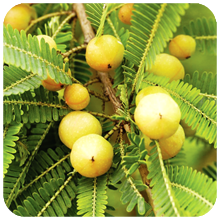
Emblica officinalis is a small to medium sized tree, reaching up to 8-18 meters in height, with a crooked trunk and spreading branches. The branches are glabrous or finely pubescent, 10-20 cm long, usually deciduous, Leaves are simple, subsessile, green, similar to pinnate leaves. The flowers are yellow-green in color. The fruit is nearly spherical, greenish yellow in color, quite smooth and hard on appearance, with six vertical stripes or furrows. Matures (ripens) in autumn. Fruits are harvested manually by climbing to upper branches which bear fruits. The taste of Amla fruit is sour and astringent, and the fruit is quite fibrous.
Chemical composition – Fruit Juice contains the highest concentration of vitamin C (478.56mg/100 ml). Hydrolysable tannins include- Emblicanine A and B, Punigluconine, Pedunculagine, Chebulinic acid (Elagitannin), Chebulagic acid (tannin Benzopyran), Corilagine (Ellagitanin), Geranine (Dehydroelagitannin), Elagotannin.
Alkaloids- Phyllanthine, Phlembeine, Phlanthydine.
Phenollic compounds – Gallic acid, methyl gallate, ellagic acid, trigonal glucose.
Glutamic acid; amino acids, proline, aspartic acid, alanine, cysteine, lysine,
Carbohydrates- Pectin
Flavonoids- Quercetin, kaempferol.
Organic acid- Cytic acid.
Properties – Emblica officinalis is considered as Rasayana (rejuvenator) and used to delay the degenerative process of the body. The fruits have soothing, liver protector, cerebroprotective properties. It is a powerful antioxidant, immunomodulator, eye tonic, carminative, digestive, laxative, aphrodisiac, rejuvenating, diuretic, antipyretic, analgesic, anti-inflammatory and anti-diabetic.
Recommendation – Diabetes, cough, asthma, bronchitis, headache, ophthalmopathy, dyspepsia, colic, flatulence, hyperacidity, peptic ulcer, erysipelas, skin diseases, leprosy, haematogenesis, inflammation, anemia, emaciation, hepatopathy, jaundice, diarrhea, dysentery, hemorrhage, leucorrhoea, menorrhagia, cardiac disorders, intermittent fever and premature graying of hair.
This plant is incorporated in natural remedies SLEMOL, GASCURE Syrup, GASCURE Tablets, GLOBY FORTE, LIVECOM Syrup, MEMO ON, SHECURE Syrup, TRIFYLA, WORM END Syrup, HEENA.




